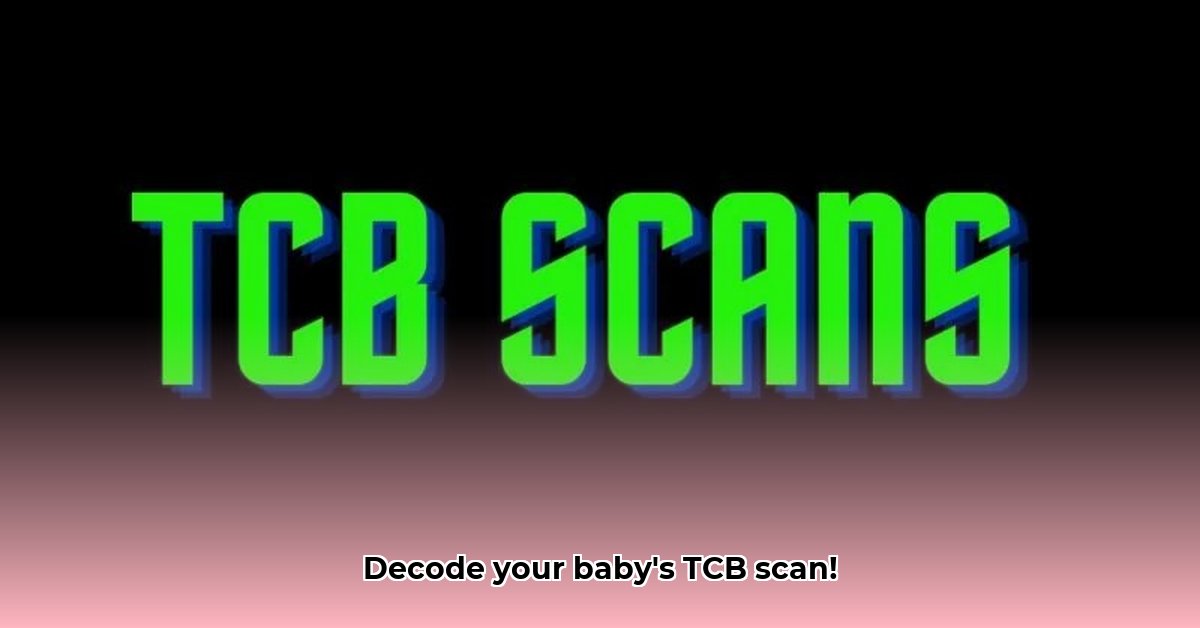Worried about jaundice in your newborn? Transcutaneous bilirubin (TcB) testing offers a quick and painless way to screen for it, all without the need for a needle prick. This guide is designed to equip you with the knowledge to understand TcB results, identify key indicators, and know when to consult your doctor. We’ll explore everything from the mechanics of the test to the factors influencing its readings, empowering you to confidently interpret your baby’s results and ensure their well-being. Let’s delve into how TcB can be a valuable tool in safeguarding your little one’s health. For more information on timing, see this helpful guide.
How to Read TcB Scan for Infants
This guide will assist you in understanding transcutaneous bilirubin (TcB) readings in newborns. It’s important to remember that a TcB reading offers only a snapshot—a helpful clue rather than the definitive answer. Always consult your baby’s doctor to properly interpret the numbers and determine the necessity of any required steps and avoid potential errors when reading TcB scan.
Decoding the TcB: A Step-by-Step Guide
TcB measures bilirubin levels in your baby’s skin. Bilirubin, a yellow pigment, can cause jaundice if levels are too high. The TcB device quickly and painlessly estimates bilirubin levels, avoiding needles. Knowing how to read a TcB scan for infants involves understanding its limitations. TcB devices use light to measure bilirubin levels non-invasively.
Step 1: Getting the Reading
A healthcare professional uses a small, handheld device, a bilirubinometer, to measure bilirubin in your baby’s skin, typically on the forehead or sternum. The device directs a flash of light into the skin and measures the intensity of specific light wavelengths that are reflected back. This provides a number in milligrams per deciliter (mg/dL) or micromoles per liter (μmol/L). This reading is more like a general health check than a detailed medical analysis.
Step 2: Considering Your Baby’s Uniqueness
Several factors can affect TcB reading accuracy. It’s not a one-size-fits-all scenario:
- Gestational Age: Premature babies (born before 38 weeks) often have higher bilirubin levels because their livers are less mature.
- Ethnicity: Some ethnic groups have a naturally higher propensity for elevated bilirubin levels.
- Feeding Method: Breastfed babies may have different bilirubin level patterns than formula-fed babies.
- Birth Trauma: Bruising during birth can lead to increased bilirubin production as the body breaks down the blood from the bruise.
- Skin Color: Skin pigment levels can affect the reading, potentially requiring a different interpretation for darker skin tones. Melanin, the pigment responsible for skin color, can interfere with the device’s light measurements, leading to underestimation of bilirubin levels.
- Age in Hours: Bilirubin levels rise in the first few days of life, peaking around the third to fifth day, before declining.
- The Device Itself: Devices may function differently, with varying accuracy and reading ranges. The calibration of the device is critical for accurate measurements.
Step 3: Using the Nomogram (The Special Chart)
The next step is using an hour-specific nomogram, a chart that considers your baby’s age in hours (gestational age if premature), and sometimes ethnicity, to determine if bilirubin levels fall within the normal range. These nomograms are constructed from data on thousands of newborns and are divided into percentile-based risk zones.
Step 4: Comparing the Reading to the Nomogram
Compare your baby’s TcB number to the nomogram’s specified range. Does the number fall within the normal range, or does it indicate the need for further evaluation of infant jaundice risk factors? A reading in a lower percentile suggests a low risk, while a reading in the 95th percentile indicates a high risk.
Understanding the Limitations: TcB Isn’t the Whole Picture
Although TcB offers a convenient, non-invasive jaundice check, it’s crucial to remember its limitations:
- It’s an Estimate: TcB only estimates total serum bilirubin (TSB). A blood test (TSB) offers a more precise result and is considered the gold standard for diagnosis. TcB measures bilirubin in the tissue, not the blood itself.
- External Factors Matter: Factors such as skin hydration, application pressure of the device, and room lighting can slightly affect the reading.
- Skin Tone Differences: TcB readings might be less accurate for babies with darker skin compared to those with lighter skin; researchers are actively working to improve this. The device may overestimate or underestimate bilirubin levels depending on skin pigmentation. This discrepancy highlights the need for careful interpretation and consideration of individual skin tone.
- Not suitable during phototherapy: The meter cannot be used in infants receiving phototherapy.
Given these limitations, doctors often use TcB with other observations of your baby’s health, such as visual assessment of jaundice progression (cephalocaudal progression), and may recommend a blood test for a more precise bilirubin measurement. TcB readings are influenced by the calibration of the device.
When to Discuss Your Concerns with Your Doctor
Contacting your healthcare provider is essential in these situations:
- High TcB Reading: If your baby’s TcB reading approaches or exceeds a specific threshold on the age-specific nomogram’s normal range.
- Signs of Jaundice Beyond the Number: If your baby is lethargic, not feeding well, has yellowing skin and eyes, or if the jaundice seems to be spreading. Jaundice typically appears on the face first and progresses down the body as levels increase.
- Doctor’s Concerns: Your healthcare provider might have concerns based on their overall baby assessment, even with a normal TcB number. This is especially true for babies discharged early from the hospital, as bilirubin levels can continue to rise after discharge.
These are good reasons to consult your healthcare provider, who can determine if further testing or treatment is needed for infant jaundice treatment options. Treatment options include phototherapy, which uses special blue-spectrum light to convert bilirubin into a water-soluble form that the body can excrete more easily, and in rare cases, exchange transfusion.
The Bottom Line: TcB, a Helpful Tool but Not a Standalone Answer
TcB is a quick and easy way for doctors to estimate your baby’s bilirubin levels. However, interpreting TcB readings requires professional expertise and shouldn’t be attempted independently. Doctors combine TcB results with their observations to determine the best care for your baby, and trust in their expertise is essential. Research continues to refine our understanding of bilirubin and jaundice management, helping us improve infant jaundice prevention.
How to adjust TcB readings for darker skin tones in newborns
Key Takeaways:
- Transcutaneous bilirubin (TcB) readings can be significantly lower in newborns with darker skin tones due to melanin’s interference with light absorption.
- This underestimation can delay necessary treatment for jaundice, potentially leading to serious complications such as acute bilirubin encephalopathy (ABE) and kernicterus.
- Accurate interpretation requires considering skin pigmentation and using appropriate correction factors, especially understanding how melanin impacts TcB accuracy.
- Total serum bilirubin (TSB) testing often provides a more reliable measurement, especially in darker-skinned infants.
- Healthcare providers must be aware of this bias and adjust their approach accordingly, using clinical judgment and considering other risk factors.
Understanding TcB and Its Limitations
TcB is a quick and easy jaundice test. It measures bilirubin levels in the skin using a special device, a bilirubinometer. While convenient, it’s not perfect. It gives a general idea but might miss some details. A significant limitation is its inaccuracy in newborns with darker skin.
Why Skin Tone Matters: The Melanin Factor
Melanin, the pigment that gives skin its color, absorbs light and interferes with TcB device’s ability to accurately measure bilirubin in individuals with higher melanin concentrations. As a result, TcB readings are often lower than the actual bilirubin levels in darker-skinned babies, potentially leading to delayed or inadequate treatment and overlooking severe hyperbilirubinemia. Melanin absorbs certain wavelengths of light, impacting TcB measurement accuracy.
How to Adjust TcB Readings for Darker Skin Tones in Newborns
There isn’t a single magic number to add to every TcB reading for darker skin. It’s more nuanced than that. Here’s a practical approach:
- Be Aware: Recognize that a lower TcB reading in a darker-skinned infant might not reflect the true bilirubin level. Don’t rely solely on the TcB result while monitoring newborn jaundice symptoms. Be vigilant for visual signs of jaundice, such as yellowing of the skin and eyes.
- Consider Clinical Clues: Observe the baby’s overall condition. Jaundice severity, feeding behavior, activity level, and the infant’s general demeanor provide crucial context for evaluating the relationship between breastfeeding and jaundice. Lethargy, poor feeding, and high-pitched crying can be signs of more severe jaundice.
- Use a Reliable Device: Different TcB devices may have varying degrees of accuracy in different skin tones. Choose a device with proven reliability across a diverse range of skin tones. Newer models often incorporate algorithms that attempt to compensate for melanin’s interference by implementing advanced TcB technology. Check if the device has specific settings or recommendations for use in different skin tones.
- **
- Water Wheel Electric Generator Provides Free Home Electricity - December 15, 2025
- Choosing the Right Portable Hydro Turbine for Your Needs - December 14, 2025
- Best Portable Hydro Generators for Off-Grid and Outdoor Power - December 13, 2025
















